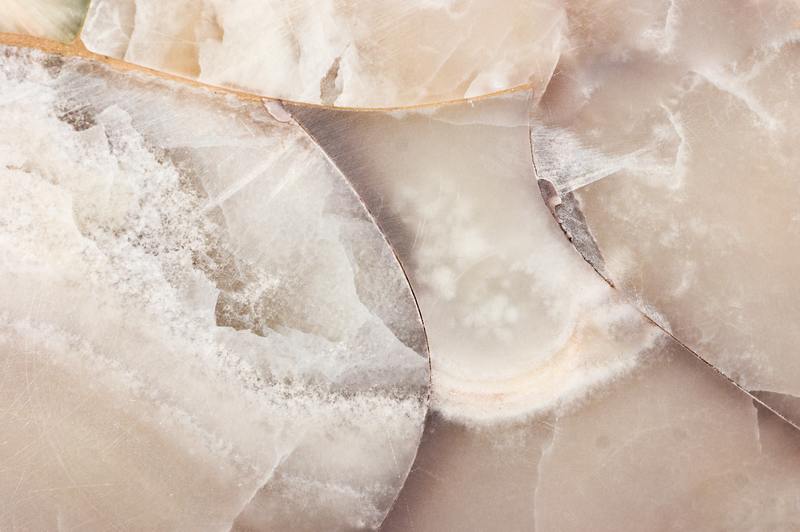To answer how can you repair water damaged marble, you have first to understand how water damage happens on marble. This article will tackle that, as well as the steps you should take in handling water-damaged marble.

Understand How Water Damage Happens On Marble
Despite marble being rock-solid, it is still porous. Hence, it can absorb water and be vulnerable to it.
It is especially susceptible to mineral deposits in hard water, which lead to spots or stains on your marble. This is also called efflorescence and is a result of moisture transmission.
Spalling is another result of water damage. Specifically, it happens when the moisture is absorbed and accumulated into the marble resulting in stress in the stone’s pores.
Lastly, certain types of marble are prone to pitting when exposed to water regularly. Pitting is like a chip in your marble which can happen when the temperature of its environment changes dramatically.
The first thing you have to do as a homeowner before concluding on your marble’s state is to assess the damage. You’ll learn more about this below.
Step #1. Assess the damage
We know by now that moisture is the leading cause of water damage on marble, which is why you should assess the moisture level of your stone. In testing for your marble’s moisture level, you have to use a protimeter.
A standard protimeter is used to read wood and drywall moisture levels. They usually have two probes that can be inserted into the drywall or wood.
However, you cannot do the same for marble. You can only place them on the stone, and it will give you a relative reading. Unfortunately, you cannot get a direct reading out of a standard protimeter.
For your reference, a 0% to 6% reading is considered relatively dry, while a 7% to 20% result is wet. If the reading goes beyond 20%, then it is regarded as very wet.
Another method of testing your marble’s moisture level is by looking at the amount of condensed water it accumulates overnight. Do this by taking a piece of plastic and securing it on the marble.
Then, leave it there for twelve hours, or overnight. If there is moisture, you will find evidence of it in the form of condensation. If you suspect your marble has soluble salts, which may lead to efflorescence, then have it tested for salt, too.
Step #2. Clean the water damage
Marble water damage may generally be due to drastic moisture changes in the environment, but it can also be due to flooding or spills. Acidic liquids like lemon juice or carbonated beverages are especially damaging to your marble’s surface. That is because they may cause discoloration on your marble.
Flooding is also an issue since it is usually contaminated water and may contain minerals that may result in salt bloom. Since it may lead to more severe problems, you should clean the water damage as soon as it happens. Or maybe after you document it if you wish to apply for an insurance claim.
If you wish to apply for an insurance claim, especially after a flooding incident, then make sure you have your receipts in order. Also, ensure that your flood insurance is still active and that the incident is a part of your insurance coverage.
Contact a lawyer to help strengthen your insurance claim. They may also serve as a third party to look over your concern if your insurance company rejects your insurance claim.
Step #3. DIY or professional
After assessing, cleaning, and contacting your insurance provider, you have to decide whether you should DIY or have it done by a professional. You have to consider the extent of the damage and your knowledge in repairing floors.
Moreover, if you wish to make the most out of your money, go to a trusted professional. This removes room for errors that may happen if you do the repairs by yourself.
However, if you wish to remove stains by yourself, you can use a baking soda-acetone mixture to remove discoloration. For more severe issues, like efflorescence, we advise you to contact a professional instead.
How To Prevent The Damage From Happening Again
1. Placemats
Prevent your marble from acquiring scratches or dirt by placing mats on your home’s entrances and in high-traffic areas. Something as simple as this can prevent your marble from pitting.
2. Remove spills
Spills can never be entirely prevented, so what you have to do is to clean them up as soon as possible. In cleaning a spill on a marble floor, blot it with a paper towel. Do not wipe it because this will spread the spill.
3. Do not use detergents
Detergents should not be used on your marble floor as it may dull your stone and it may be harmful to its finish. Detergents with acid may also cause discoloration and etch marks. On the other hand, alkaline-containing cleaning solutions may rid your flooring of its shine.
Conclusion
Marble is rock-solid yet fragile. This article is a testament to that, and while it is pretty effortless to read about removing its stains, maintaining it is a different issue altogether. Despite that, we hope you have gained knowledge to know how can you repair water damaged marble from this article.
